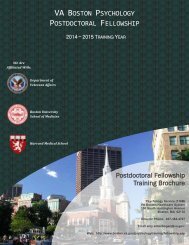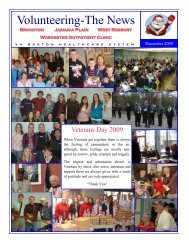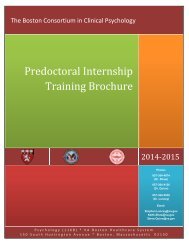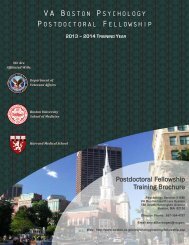cardiovascular issues after spinal cord injury - VA Boston Healthcare ...
cardiovascular issues after spinal cord injury - VA Boston Healthcare ...
cardiovascular issues after spinal cord injury - VA Boston Healthcare ...
You also want an ePaper? Increase the reach of your titles
YUMPU automatically turns print PDFs into web optimized ePapers that Google loves.
CARDIO<strong>VA</strong>SCULAR ISSUES AFTER SPINAL CORD INJURY19 th Annual SCI SymposiumSunil Sabharwal, MDCardiovascular dysfunction is an important cause of morbidity in SCI, and is one of the two topcauses of death in SCI.1. Cardiovascular Function in SCI• The parasympathetic supply via the vagus (cranial nerve X) is spared in most SCI.Sympathetic outflow occurs below the T6 level. Injuries above this level generally result inloss of input to sympathetic neurons. So autonomic imbalance occurs in injuries at or aboveT6 with significant alterations in <strong>cardiovascular</strong> system control.• In addition, there are indirect effects of immobility and other SCI related conditions on<strong>cardiovascular</strong> function.2. Cardiovascular Concerns in SCI - Occur throughout the care continuum• AcuteArrhythmias, bradycardia, cardiac arrest• Early, but could be a continuing concernOrthostatic hypotensionVenous thrombo-embolism• Ongoing <strong>issues</strong>Autonomic dysreflexiaReduced <strong>cardiovascular</strong> fitnessCardiovascular effects of medications in SCI• Cardiovascular co-morbidities with agingInfluence on coronary artery diseasePeripheral vascular disease3. Cardiac Arrhythmias• Arrhythmias are predominantly a concern in the first few weeks <strong>after</strong> <strong>injury</strong>, especiallybradycardia and even cardiac arrest due to unopposed vagal tone. May be exacerbated bysuctioning. Treatment may include atropine, occasionally a pacemaker.• Arrhythmias do not seem to play a significant role in persons with chronic SCI.4. Orthostatic Hypotension and Low Baseline Blood Pressure• Orthostatic hypotension (OH) can occur with acute or chronic cervical/ high thoracic SCI dueto altered sympathetic response to posture changes, decreased vascular tone, and decreasedvenous return. It is more likely to occur with complete injuries.• Symptoms and signs- can include dizziness, pallor, blurred vision, excess sweating abovethe level of <strong>injury</strong>, fainting during position change. Symptoms may correlate with alteredcerebral blood flow vs. the absolute blood pressure and often diminish with time despitecontinued evidence of decreased blood pressure.o Symptoms may be worse <strong>after</strong> eating due to post-prandial shunting of blood to thedigestive system, in hot environment or <strong>after</strong> heavy physical exertion, and <strong>after</strong>prolonged recumbency. Maybe exacerbated by side effect of medications, sepsis,dehydrationo Post-traumatic syringomyelia may sometimes present with worsening OHManagement• Non-pharmacologicalCardiovascular Issues in SCI – Sabharwal 1
oooooReview medications for hypotensive side-effects; minimize exacerbating factorsGradual sitting from the recumbent position; progressive postural challengesElevated leg rests; reclining or tilt-in-space wheelchairCompression stockings, abdominal binderIncreased salt and fluid intake if indicated• Medications:oFludrocortisone acetate (Florinef)Dose: 0.1 -0.4 mgMechanism: Salt and water retention/ delayed actionSide effects: HTN, CHF, hypokalemia, hypernatremia, weight gain, edemao Ephedrine sulphate (Ephedrine)Dose: 25 mg bid - 50 mg tid, can be given prn prophylactically(e.g 20-30 minutes before arising in AM, or before therapy)Mechanism: Alpha & beta sympathetic agonistSide effects: Tachycardia, arrhythmias, HTN, palpitations, urine retention,insomnia, sweating, tremors, tachyphylaxis, abuse potentialo Midoridine hcl (ProAmitine)Dose: 2.5 mg tid - 10 mg tid, avoid giving <strong>after</strong> 5PM to avoid supine HTNMechanism: Alpha-1 adrenoreceptor agonistSide effects: Headache, paresthesias, dysuria, pruritis, piloerection, supine HTN5. Venous Thrombo-embolism• The incidence of deep venous thrombosis (DVT) is maximal in the first few weeks <strong>after</strong> SCI.• See the Consortium for Spinal Cord Medicine’s Clinical Practice Guidelines on“Prevention of Thromboembolism in Spinal Cord Injury" for detailedrecommendations. In brief, recommendations include:o Compression hose or pneumatic devices should be applied to the legs of all patientsfor the first two weeks following <strong>injury</strong>.o Anticoagulant prophylaxis with either low-molecular weight heparin or adjusted doseunfractionated heparin should be initiated within 72 hours <strong>after</strong> SCI, provided there isno active bleeding or coagulopathy.o The duration of anticoagulant prophylaxis should be individualized depending on theneed, medical condition, functional status, and the risk to the patient. Anticoagulantsshould be continued until discharge in patients with incomplete injuries, for 8 weeksin patients with uncomplicated complete motor <strong>injury</strong>, and for 12 weeks or untildischarge for those with complete motor <strong>injury</strong> and other risk factors (e.g. lower limbofractures, history of thrombosis, cancer, heart failure, obesity, or age over 70).Vena cava filter placement is indicated in patients with SCI who have failedanticoagulants prophylaxis or who have a contraindication to anticoagulation (such asCNS or GI bleeding). Filters should also be considered in patients with completemotor paralysis due to high cervical <strong>cord</strong> <strong>injury</strong> (C2, C3), or with poorcardiopulmonary reserve. However, filter placement is not a substitute forthromboprophylaxis.• In symptomatic patients perform ultrasound of legs and/or ventilation/perfusion lungscanning. If clinical suspicion is strong but tests are negative or indeterminate, considervenography of the legs, lung spiral CT, or pulmonary angiography.• With documented DVT, mobilization and exercise of the lower extremity should bewithheld 48-72 hours until appropriate medical therapy is implemented.• Risk for thrombo-embolism is much lower in chronic SCI, and may not be significantlyincreased <strong>after</strong> the first year of <strong>injury</strong> compared to the general population. However,Cardiovascular Issues in SCI – Sabharwal 2
einstitution of prophylactic measures should be considered in chronic SCI patients ifthey have other risk factors (e.g. previous DVT), are immobilized for a long time, orundergo surgical procedures that increase risk for development of DVT in any patient.6. Autonomic Dysreflexia:• Results from noxious stimuli which in turn trigger sympathetic hyperactivity. Inhibitoryimpulses that arise above the level of <strong>injury</strong> are blocked so that there is unopposedsympathetic outflow. Denervation hypersenstivity of peripheral adrenergic receptors belowthe level of injry may also contribute to the pathophysiology.• SCI at the thoracic level T6 or above, i.e. above the major splanchnic outflow, predisposes toautonomic dysreflexia (AD), though occurrence with injuries as low as T8 is described.• The feature of most concern with autonomic dysreflexia is the significant and potentially lifethreateningelevation in blood pressure.• Recognize the signs and symptoms of autonomic dysreflexia, including:- Sudden, significant increase in blood pressure.- Pounding headache- Bradycardia (may be a relative slowing so that the heart rate is still within the normalrange)- Profuse sweating above the level of the lesion, especially in the face, neck, andshoulders, or possibly below the level of the lesion.- Piloerection or goose bumps above or possibly below the level of the lesion- Cardiac arrhythmias, atrial fibrillation, premature ventricular contractions, andatrioventricular conduction abnormalities- Flushing of the skin above the level of the lesion, especially in the face, neck, andshoulders, or possibly below the level of lesion.- Blurred vision- Appearance of spots in the patient's visual fields- Nasal congestion.- Feelings of apprehension or anxiety over an impending physical problem- Minimal or no symptoms, despite a significantly elevated blood pressure (silentautonomic dysreflexia).• Management: The Consortium for Spinal Cord Medicine has published clinical practiceguidelines for the acute management of autonomic dysreflexia. The summary of thesetreatment guidelines is as follows 1 :- Check the individual’s blood pressure.- If the blood pressure is elevated and the individual is supine, immediately sit the personup.- Loosen any clothing or constrictive devices.- Monitor the blood pressure and pulse frequently.- Quickly survey the individual for the instigating causes, beginning with the urinarysystem.- If an indwelling urinary catheter is not in place, catheterize the individual.- Prior to inserting the catheter, instill 2 percent lidocaine jelly (if readily available) intothe urethra and wait several minutes.- If the individual has an indwelling urinary catheter, check the system along its entirelength for kinks, folds, constrictions, or obstructions and for correct placement of theindwelling catheter. If a problem is found, correct it immediately.1 From the Consortium for Spinal Cord Medicine Clinical Practice Guidelines on Acute Management ofAutonomic Dysreflexia. 2001. Paralyzed Veterans of America.Cardiovascular Issues in SCI – Sabharwal 3
- If the catheter appears to be blocked, gently irrigate the bladder with a small amount offluid, such as normal saline at body temperature. Avoid manually compressing ortapping on the bladder.- If the catheter is not draining and the blood pressure remains elevated, remove andreplace the catheter.- Prior to replacing the catheter, instill 2 percent lidocaine jelly (if readily available) intothe urethra and wait several minutes.- If the catheter cannot be replaced, consider attempting to pass a coude catheter, or consultan urologist.- Monitor the individual’s blood pressure during bladder drainage.- If acute symptoms of autonomic dysreflexia persist, including a sustained elevated bloodpressure, suspect fecal impaction.- If the elevated blood pressure is at or above 150 mm Hg systolic, consider pharmacologicmanagement to reduce the systolic blood pressure without causing hypotension prior tochecking for fecal impaction.- Use an antihypertensive agent with rapid onset and short duration (e.g. nifedipine biteand swallow, 2% nitroglycerin ointment, or prazosin) while the causes of autonomicdysreflexia are being investigated.- Monitor the individual for symptomatic hypotension.- If fecal impaction is suspected, check the rectum for stool, using the following procedure:With a gloved hand, instill a topical anesthetic agent such as 2 percent lidocaine jellygenerously into the rectum. Wait approximately 5 minutes for sensation in the area todecrease. Then, with a gloved hand, insert a lubricated finger into the rectum and checkfor the presence of stool. If present, gently remove, if possible. If autonomic dysreflexiabecomes worse, stop the manual evacuation. Instill additional topical anesthetic andrecheck the rectum for the presence of stool <strong>after</strong> approximately 20 minutes.- If precipitating cause of AD is not yet determined, check for other less frequent causes.- Monitor the individual’s symptoms and blood pressure for a least 2 hours <strong>after</strong> resolutionof the autonomic dysreflexia episode to make sure that it does not recur.- If there is poor response to the retreatment specified above and/or if the cause of thedysreflexia has not been identified, strongly consider admitting the individual to thehospital to be monitored, to maintain pharmacologic control of the blood pressure, and toinvestigate other causes of the dysreflexia.- Document the episode in the individual’s medical re<strong>cord</strong>. This re<strong>cord</strong> should include thepresenting signs and symptoms and their course, treatment instituted, re<strong>cord</strong>ings of bloodpressure and pulse, and response to treatment. The effectiveness of the treatment may beevaluated ac<strong>cord</strong>ing to the level of outcome criteria reached:- The cause of the autonomic dysreflexia episode has been identified.- The blood pressure has been restored to normal limits for the individual (usually 90to 110 systolic mm Hg for a tetraplegic person in the sitting position).- The pulse rate has been restored to normal limits.- The individual is comfortable, with no signs or symptoms of autonomic dysreflexia,of increased intracranial pressure, or of heart failure.- Once the individual with <strong>spinal</strong> <strong>cord</strong> <strong>injury</strong> has been stabilized, review the precipitatingcauses with the individual, members of the individual’s family, significant others, andcaregivers and provide education as necessary. Individuals with SCI and their caregiversshould be able to recognize and treat AD and seek emergency treatment if it is notpromptly resolved. It is recommended that an individual with a <strong>spinal</strong> <strong>cord</strong> <strong>injury</strong> begiven a written description of treatment for autonomic dysreflexia at the time ofdischarge that can be referred to in an emergency.Cardiovascular Issues in SCI – Sabharwal 4
7. Cardiovascular Effects of Medications in SCI: E.g. Sildenafil (Viagra)o Beware of fatal interaction of Sildenafil with nitrates (e.g. nitropaste for AutonomicDysreflexia treatment)8. Coronary Artery Disease• Coronary Artery Disease (CAD) has become an important cause of mortality and morbidityin SCI with increasing survival and aging of the SCI population.• Specific risk factors for CAD may be increased in SCI. These include – low levels of HDL(high density lipoprotiens), physical inactivity, increased proportion of body fat, and higherincidence of glucose intolerance. The significance of additional emerging CHD risk factorsin SCI still needs to be defined.• Symptoms and signso Individuals with SCI above T5 may not perceive chest pain with angina.o May present atypically with nausea, unexplained autonomic dysreflexia, jaw pain,episodic dyspnea, syncope, changes in spasticity.ooOn the other hand, GE reflux, which is common in SCI may be mistaken for anginaCaution in interpreting signs of cardiac failure (eg limb edema could be due todependency or CHF, lung crackles could be due to atelectasis vs left heart failure)• Diagnostic Evaluationo Traditional treadmill exercise stress test can not be doneo Arm ergometry can be done in paraplegia. But arm exercise typically produces lowerheart rates than leg exercise, and may miss detection of heart disease.o Pharmacological stress testing is often the most practical option. Consist ofadministration of a pharmacological agent such as dipyridamole (Persantin),adenosine, or dobutamine to induce cardiac stress, in combination with a form ofcardiac imaging (thallium 201 scanning or 2-D echocardiography).• Prevention‣ Reduction of cardiac risk factors. Because of exercise limitations in SCI,reduction of other cardiac risk factors is even more important.o Smoking cessation (counseling, behavioral techniques, nicotine patches or gum)o Detection and control of hypertension (JNC 7 guidelines)o Weight control, diabetic control, lipid management (diet/ drugs - NCEP ATP IIIguidelines)o Physical Activity/ Exercise in SCIo Activities of daily living alone typically do not result in <strong>cardiovascular</strong>conditioning. Even modest exercise can achieve health benefits, though maynot be able to exercise enough to produce definite <strong>cardiovascular</strong> benefitswith higher levels of <strong>injury</strong>.o Exercise capacity in SCI is limited by two main factors: paralysis of thelarge lower extremity muscles, and the blunted sympathetic response toexercise.o Depending on the level of <strong>injury</strong>, exercise options may include arm-crankergometry, hand cycling, endurance sports, swimming, Circuit resistancetraining and electrically induced exercise‣ Management of Coronary Artery Disease in SCIo Spectrum of interventions available to able-bodied should be offered (Life stylechanges, medications, angioplasty, CABG)o May not be able to tolerate traditional anti-anginal medication doses due to lowblood pressure, so introduction of medications may have to be done cautiouslyCardiovascular Issues in SCI – Sabharwal 5
9. Peripheral Vascular Disease• Significant problem in aging patients with SCI, especially in diabetics and smokers• Lack of pain and cardinal symptoms of limb ischemia such as intermittent claudication maydelay detection of vascular disease. May present in advanced stages with gangrene• May be contributing to the pathogenesis of non-healing skin ulcers• Minimizing risk factors such as smoking, diabetes and hyperlipidemia is a key part ofmanagementTABLESTable 1: Cardiovascular Issues in SCIHypotensionLow baseline blood pressureOrthostatic hypotensionBradycardia, arrhythmias, cardiac arrestAutonomic dysreflexiaReduced <strong>cardiovascular</strong> fitness and altered exercise capacityInfluence on coronary and peripheral artery diseaseImpact on risk factorsSilent ischemia, atypical presentationsSpecial diagnostic and treatment considerationsVenous thromboembolismCardiovascular effects of medications in SCITable 2: Reversible Factors Exacerbating Symptomatic Postural Hypotension in SCIProlonged recumbencyRapid position changeHeavy mealsPhysical exertionHot environmentDehydration (diarrhea, viral illness)SepsisMedications: Diuretics, antidepressants, alpha blockers, narcoticsTable 3: Management of Orthostatic Hypotension in SCIIdentify and minimize exacerbating factors (Table 2)Increase salt intakeCompression stockings, abdominal binderTilt table, progressive postural challengesHead-up tilt during sleepElevating wheelchair leg restsReclining or tilt-in-space wheelchairFunctional electrical stimulationBiofeedback? Body-weight supported treadmill trainingPharmacological treatmentFludrocortisoneSympathomimetic aminesEphedrineMidodrineOther medications (Little reported use for SCI related OH)Cardiovascular Issues in SCI – Sabharwal 6
Table 4: Symptoms and Signs of Autonomic DysreflexiaSudden, significant increase in blood pressurePounding headacheFlushing of the skin above the level of the SCI, or possibly belowBlurred vision, appearance of spots in the patient's visual fieldsNasal congestionProfuse sweating above the level of the SCI, or possibly below the levelPiloerection or goose bumps above the level of SCI, or possibly belowBradycardia (may be a relative slowing only and still within normal range)Cardiac arrhythmiasFeelings of apprehension or anxietyMinimal or no symptoms, despite a significantly elevated blood pressureTable 5: Potentially Increased Cardiovascular Risk Factors <strong>after</strong> SCIDecreased physical activityLow HDL cholesterolImpaired glucose tolerance, insulin resistanceIncreased proportion of body fatPsychosocial factors (Depression, Social isolation)Hypothesized effects of SCI on emerging risk factorsTable 6: Key Prevention Targets for Coronary Heart Disease (CHD)Smoking cessationLipid management to goalBlood pressure controlWeight managementPhysical activityDiabetic management to goalAdditional components of secondary prevention with known CHDAntiplatelet agents (aspirin), anticoagulantsRenin-angiotensin aldosterone system blockersBeta blockersTable 7: Unique Issues in the Diagnosis of CHD <strong>after</strong> SCIAtypical presentations, lack of chest painUnder-diagnosis of coronary heart disease (CHD)Delayed treatment; Inadequate secondary preventionConfusing physical signsDependent edema versus heart failureAtelectasis versus left ventricular failureNonspecific ST-segment and T-wave changes in SCICardiac stress testingInability to perform traditional treadmill testSuboptimal sensitivity of arm versus leg exerciseDifficulty in interpreting significance of exercise induced hypotensionIndication for pharmacologic stress testingCardiovascular Issues in SCI – Sabharwal 7
References1. Teasell RW, Arnold MO, Krassioukov A, et al. Cardiovascular consequences of loss ofsupra<strong>spinal</strong> control of the sympathetic nervous system <strong>after</strong> <strong>spinal</strong> <strong>cord</strong> <strong>injury</strong>. Arch PhysMed Rehabil 81(4):506-516. 2000.Review of the pathophysiology and autonomic mechanisms underlying <strong>cardiovascular</strong>dysfunction in SCI2. Blackmer J. Orthostatic hypotension in <strong>spinal</strong> <strong>cord</strong> injured patients. J Spinal Cord Med20(2):212-217. 1997Review pathophysiology, clinical features, and management of orthostatic hypotension in SCI3. Expert panel on detection, evaluation, and treatment of high blood cholesterol in adults.Executive summary of the third report of the national cholesterol education program (NCEP)expert panel on detection, evaluation, and treatment of high blood cholesterol in adults (Adulttreatment panel III). JAMA 285 (19):2486-2497. 2001Updated guidelines for cholesterol and lipid management in adults4. Joint National Committee on Prevention, Detection, Evaluation, and Treatment of HighBlood Pressure. The Seventh Report of the Joint National Committee on Prevention,Detection, Evaluation, and Treatment of High Blood Pressure: the JNC 7 report. JAMA. 2003May 21;289(19):2560-72. (Also at www.nhlbi.nih.gov/guidelines/hypertension)Blood pressure management guidelines by national experts5. Pearson TA, Blair SN, Daniels SR, et al: American Heart Association Guidelines for PrimaryPrevention of Cardiovascular Disease and Stroke: 2002 Update: Consensus Panel Guide toComprehensive Risk Reduction for Adult Patients Without Coronary or OtherAtherosclerotic Vascular Diseases. American Heart Association Science Advisory andCoordinating Committee. Circulation 2002;106:388–916. Myers J, Lee M, Kiratli J. Cardiovascular disease in <strong>spinal</strong> <strong>cord</strong> <strong>injury</strong>: an overview ofprevalence, risk, evaluation, and management. Am J Phys Med Rehabil. 2007 Feb;86(2):142-52.7. Jacobs PL, Nash MS: Exercise recommendations for individuals with <strong>spinal</strong> <strong>cord</strong> <strong>injury</strong>.Sports Med 2004;34:727–51Review of benefits, risks, and special considerations for recommending exercise for peoplewith SCI8. Groah SL, Weitzenkamp D, Sett P, et al: The relationship between neurological level of<strong>injury</strong> and symptomatic <strong>cardiovascular</strong> disease risk in the aging <strong>spinal</strong> injured. Spinal Cord2001;39:310-7In this study of 545 subjects with chronic SCI, risk of developing coronary heart disease wasrelated to completeness and level of <strong>injury</strong>/9. Bauman WA, Spungen AM. Coronary heart disease in individuals with <strong>spinal</strong> <strong>cord</strong> <strong>injury</strong>:assessment of risk factors. Spinal Cord. 2008 Jul;46(7):466-76.Overview of the influence of SCI on risk factors for coronary heart diseaseCardiovascular Issues in SCI – Sabharwal 8
10. Stiens S, Johnson M, Lyman P: Cardiac Rehabilitation in the patient with <strong>spinal</strong> <strong>cord</strong> <strong>injury</strong>.Phys Med Rehabil Clin North Am 6:263-296, 1995A discussion about adapting a cardiac rehabilitation program for individuals with SCI11. Jacobs PJ and Nash MS: Modes, benefits, and risks of voluntary and electrically assistedexercise in persons with <strong>spinal</strong> <strong>cord</strong> <strong>injury</strong>.Review of exercise programs to address <strong>cardiovascular</strong> conditioning and fitness of peoplewith tetraplegia and paraplegia.12. Devivo MJ, Krause JS, Lammerste DP: Recent trends in mortality and causes of death amongpersons with <strong>spinal</strong> <strong>cord</strong> <strong>injury</strong>. Arch Phys Med Rehabil 80 (11): 1411-1419, 1999In this multi-center cohort study, cardiac disease was one of the top two causes of death bothwithin the first year post-<strong>injury</strong> and beyond the first year <strong>after</strong> <strong>injury</strong>.13. Janssen TW, Dallmeijer AJ et al. Normative values and determinants of physical capacity inindividuals with <strong>spinal</strong> <strong>cord</strong> <strong>injury</strong>. J Rehabil Res Dev 39:29-39. 2002Provides physical capacity norms for men with tetraplegia and paraplegia.14. Consortium for Spinal Cord Medicine. Prevention of thromboembolism in <strong>spinal</strong> <strong>cord</strong> <strong>injury</strong>.Clinical Practice Guidelines. 2 nd edition. 1999. Paralyzed Veterans of America.Comprehensive recommendations for prevention of venous thromboembolism in SCI15. Consortium for Spinal Cord Medicine. Acute Management of Autonomic Dysreflexia.Clinical Practice Guidelines. 2 nd edition. 2001. Paralyzed Veterans of America.16. Sabharwal S: Cardiovascular Dysfunction in Spinal Cord Disorders. In: Lin V (ed). SpinalCord Medicine. 2 nd Ed. New York: Demos Publishing; 2010. p241-255.Review of pathophysiology, manifestations, & management of <strong>cardiovascular</strong> <strong>issues</strong> in SCICardiovascular Issues in SCI – Sabharwal 9









